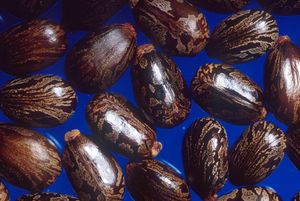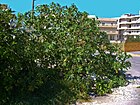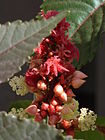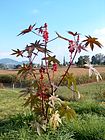Note: This is a project under development. The articles on this wiki are just being initiated and broadly incomplete. You can Help creating new pages.
Difference between revisions of "Ricinus communis - Gandharvataila"
m (Prabhakar moved page Gandharvataila to Gandharvataila (Ricinus communis)) |
(→List of Ayurvedic medicine in which the herb is used) |
||
| (30 intermediate revisions by 2 users not shown) | |||
| Line 1: | Line 1: | ||
[[File:Castor beans.jpg|thumb|right|'' Castor beans'', ''Gandharvataila'']] | [[File:Castor beans.jpg|thumb|right|'' Castor beans'', ''Gandharvataila'']] | ||
| + | '''Ricinus communis''' is a vegetable oil obtained by pressing the seeds of the castor oil plant. Castor oil is a colorless to very pale yellow liquid with a distinct taste and odor once first ingested. | ||
| − | + | ==Uses== | |
| + | {{Uses|Wounds}}, {{Uses|Cuts}}, {{Uses|Snakebites}}, {{Uses|Curing liver disorders}}, {{Uses|Skin eruptions}}, {{Uses|Blotches}}, {{Uses|Pimples}}, {{Uses|Diarrhea}}, {{Uses|Sore throats}}.<ref name="Uses"/> | ||
| − | + | ==Parts Used== | |
| + | {{Parts Used|Root}}, {{Parts Used|Leaf}}, {{Parts Used|Seed}}, {{Parts Used|Extracted Oil}}. | ||
| − | + | ==Chemical Composition== | |
| + | Contains volatile oils, flavonoids, apigenin, luteolin, quercetin, kaempferol, tiliroside, triterpene glycosides including euscapic acid and tormentic acid, phenolic acids, and 3%–21% tannins<ref name="chemical composition"/> | ||
| + | ==Common names== | ||
| + | {{Common names|sa=Yeranda|kn=Oudla|ml=Chittamankku|ta=Amanakku|te=Amuda|hi=Arandi|en=Castor bean}} | ||
| − | == | + | ==Properties== |
| + | Reference: Dravya - Substance, Rasa - Taste, Guna - Qualities, Veerya - Potency, Vipaka - Post-digesion effect, Karma - Pharmacological activity, Prabhava - Therepeutics. | ||
| + | ===Dravya=== | ||
| + | ===Rasa=== | ||
| + | Tikta (Bitter), Kashaya (Astringent) | ||
| + | ===Guna=== | ||
| + | Laghu (Light), Ruksha (Dry), Tikshna (Sharp) | ||
| + | ===Veerya=== | ||
| + | Ushna (Hot) | ||
| + | ===Vipaka=== | ||
| + | Katu (Pungent) | ||
| + | ===Karma=== | ||
| + | Kapha, Vata | ||
| + | ===Prabhava=== | ||
| − | + | ==Habit== | |
| + | {{Habit|Herb}} | ||
| − | + | ==Identification== | |
| − | + | ===Leaf=== | |
| − | + | {{Leaf|Simple|Alternate|Palmately 6-8-lobed, peltate, to 20 x 24 cm; lobes 9-15 x 3-6 cm, lanceolate, margin coarsely serrate, apex acuminate; petiole to 18 cm long.}}<ref name="Leaf"/> | |
| − | |||
| − | |||
| − | |||
| − | |||
| − | |||
| − | + | ===Flower=== | |
| + | {{Flower|Unisexual|Terminal paniculate racemes|Yellow|Many|Male flowers below, female ones above. Male flowers: perianth cupular, 3-5-lobed, c. 4 mm long, lanceolate; stamens many, filaments connate, repeatedly branched. Flowering season is December to March}} | ||
| − | == | + | ===Fruit=== |
| + | {{Fruit|Capsule|1.6-2 cm across||3-lobed, Prickly|Seeds oblong, Smooth, Marbled, Carunculate|Fruiting season is December to March}} | ||
| − | + | ===Other features=== | |
| − | + | ||
| − | + | ==List of Ayurvedic medicine in which the herb is used== | |
| + | [[Vishatinduka Taila]], [[Maharasnadi kashayam]], [[Chaturmukha ras]], [[Eranda pak]], [[Gandharvahastadi kashayam]], [[Lohaasava]] | ||
| + | <ref name="Ayurvedic preparations"/> | ||
| + | |||
| + | ==Where to get the saplings== | ||
| + | ==Mode of Propagation== | ||
| + | {{Propagation|Seeds}} | ||
| + | |||
| + | ==How to plant/cultivate== | ||
| + | Can be easily grown from seed. The seeds are explosively released when the fruit are mature, thereby aiding their spread. They are also often dispersed by floodwaters and animals (e.g. rodents and birds). Humans also spread the seeds in dumped garden waste, mud, soil and on vehicles and machinery.<ref name="How to plant/cultivate"/> | ||
| + | |||
| + | ==Commonly seen growing in areas== | ||
| + | {{Commonly seen|Roadsides}}, {{Commonly seen|Vacant plots}}, {{Commonly seen|Wastelands}}. | ||
| + | |||
| + | ==Photo Gallery== | ||
| + | <gallery class="left" caption="" widths="140px" heights="140px"> | ||
| + | File:Ricinus communis 001.JPG| | ||
| + | File:Ricinus comm leaves.jpg|General aspect of plant with flowers and young fruits | ||
| + | File:Ricinus communis4.jpg|General aspect | ||
| + | File:Pl Lutowiska Bauerngarten.jpg|In a Polish garden | ||
| + | File:Ricinus communis.jpg | ||
| + | File:Ricinus communis001.JPG | ||
| + | File:CastorBean Leaves Flowers and YoungFruit.jpg |Leaves, flowers, young fruit of wild plant | ||
| + | File:Young castor bean plant showing prominent cotyledons.jpg|Young plant showing prominent cotydledons (emryonic leaves) of wild plant | ||
| + | </gallery> | ||
| + | |||
| + | ==References== | ||
| + | |||
| + | <references> | ||
| + | <ref name="chemical composition">[https://www.sciencedirect.com/science/article/pii/S0378874112006393?via%3Dihub Sciencedirect]</ref> | ||
| + | |||
| + | <ref name="Leaf">[https://indiabiodiversity.org/species/show/230990 Cultivation details]</ref> | ||
| + | <ref name="Ayurvedic preparations">[https://easyayurveda.com/2014/12/12/castor-benefits-use-research-side-effects/ Ayurvedic preparations]</ref> | ||
| + | |||
| + | <ref name="How to plant/cultivate">[https://keyserver.lucidcentral.org/weeds/data/media/Html/ricinus_communis.htm Cultivation details]</ref> | ||
| + | |||
| + | |||
| + | <ref name="Uses">Karnataka Medicinal Plants Volume - 2 by Dr.M. R. Gurudeva, Page No. 746</ref> | ||
| − | |||
| − | |||
| − | |||
| − | |||
| − | |||
| − | |||
| − | |||
| − | |||
| − | |||
</references> | </references> | ||
| − | == External Links == | + | ==External Links== |
| + | * [http://www.krishisewa.com/articles/production-technology/85-castor-cultivation.html Ricinus communis on krishisewa.com] | ||
| + | * [http://www.agrifarming.in/castor-cultivation-information-guide/ Ricinus communis on agrifarming.in] | ||
| + | * [http://balconygardenweb.com/how-to-grow-castor-oil-plant-care-and-growing-castor-beans/ Ricinus communis on http://balconygardenweb.com] | ||
| + | * [https://www.sciencedirect.com/science/article/pii/S0925857413001729 Ricinus communis on science direct] | ||
| − | |||
| − | |||
[[Category:Herbs]] | [[Category:Herbs]] | ||
| + | [[Category:Euphorbiaceae]] | ||
Latest revision as of 13:08, 2 April 2022
Ricinus communis is a vegetable oil obtained by pressing the seeds of the castor oil plant. Castor oil is a colorless to very pale yellow liquid with a distinct taste and odor once first ingested.
Contents
- 1 Uses
- 2 Parts Used
- 3 Chemical Composition
- 4 Common names
- 5 Properties
- 6 Habit
- 7 Identification
- 8 List of Ayurvedic medicine in which the herb is used
- 9 Where to get the saplings
- 10 Mode of Propagation
- 11 How to plant/cultivate
- 12 Commonly seen growing in areas
- 13 Photo Gallery
- 14 References
- 15 External Links
Uses
Wounds, Cuts, Snakebites, Curing liver disorders, Skin eruptions, Blotches, Pimples, Diarrhea, Sore throats.[1]
Parts Used
Root, Leaf, Seed, Extracted Oil.
Chemical Composition
Contains volatile oils, flavonoids, apigenin, luteolin, quercetin, kaempferol, tiliroside, triterpene glycosides including euscapic acid and tormentic acid, phenolic acids, and 3%–21% tannins[2]
Common names
| Language | Common name |
|---|---|
| Kannada | Oudla |
| Hindi | Arandi |
| Malayalam | Chittamankku |
| Tamil | Amanakku |
| Telugu | Amuda |
| Marathi | NA |
| Gujarathi | NA |
| Punjabi | NA |
| Kashmiri | NA |
| Sanskrit | Yeranda |
| English | Castor bean |
Properties
Reference: Dravya - Substance, Rasa - Taste, Guna - Qualities, Veerya - Potency, Vipaka - Post-digesion effect, Karma - Pharmacological activity, Prabhava - Therepeutics.
Dravya
Rasa
Tikta (Bitter), Kashaya (Astringent)
Guna
Laghu (Light), Ruksha (Dry), Tikshna (Sharp)
Veerya
Ushna (Hot)
Vipaka
Katu (Pungent)
Karma
Kapha, Vata
Prabhava
Habit
Identification
Leaf
| Kind | Shape | Feature |
|---|---|---|
| Simple | Alternate | Palmately 6-8-lobed, peltate, to 20 x 24 cm; lobes 9-15 x 3-6 cm, lanceolate, margin coarsely serrate, apex acuminate; petiole to 18 cm long. |
Flower
| Type | Size | Color and composition | Stamen | More information |
|---|---|---|---|---|
| Unisexual | Terminal paniculate racemes | Yellow | Many | Male flowers below, female ones above. Male flowers: perianth cupular, 3-5-lobed, c. 4 mm long, lanceolate; stamens many, filaments connate, repeatedly branched. Flowering season is December to March |
Fruit
| Type | Size | Mass | Appearance | Seeds | More information |
|---|---|---|---|---|---|
| Capsule | 1.6-2 cm across | 3-lobed, Prickly | Seeds oblong, Smooth, Marbled, Carunculate | Fruiting season is December to March |
Other features
List of Ayurvedic medicine in which the herb is used
Vishatinduka Taila, Maharasnadi kashayam, Chaturmukha ras, Eranda pak, Gandharvahastadi kashayam, Lohaasava [4]
Where to get the saplings
Mode of Propagation
How to plant/cultivate
Can be easily grown from seed. The seeds are explosively released when the fruit are mature, thereby aiding their spread. They are also often dispersed by floodwaters and animals (e.g. rodents and birds). Humans also spread the seeds in dumped garden waste, mud, soil and on vehicles and machinery.[5]
Commonly seen growing in areas
Roadsides, Vacant plots, Wastelands.
Photo Gallery
References
- ↑ Karnataka Medicinal Plants Volume - 2 by Dr.M. R. Gurudeva, Page No. 746
- ↑ Sciencedirect
- ↑ Cultivation details
- ↑ Ayurvedic preparations
- ↑ Cultivation details
External Links
- Ayurvedic Herbs known to be helpful to treat Wounds
- Ayurvedic Herbs known to be helpful to treat Cuts
- Ayurvedic Herbs known to be helpful to treat Snakebites
- Ayurvedic Herbs known to be helpful to treat Curing liver disorders
- Ayurvedic Herbs known to be helpful to treat Skin eruptions
- Ayurvedic Herbs known to be helpful to treat Blotches
- Ayurvedic Herbs known to be helpful to treat Pimples
- Ayurvedic Herbs known to be helpful to treat Diarrhea
- Ayurvedic Herbs known to be helpful to treat Sore throats
- Herbs with Root used in medicine
- Herbs with Leaf used in medicine
- Herbs with Seed used in medicine
- Herbs with Extracted Oil used in medicine
- Herbs with common name in Kannada
- Herbs with common name in Hindi
- Herbs with common name in Malayalam
- Herbs with common name in Tamil
- Herbs with common name in Telugu
- Herbs with common name in Sanskrit
- Herbs with common name in English
- Habit - Herb
- Index of Plants which can be propagated by Seeds
- Herbs that are commonly seen in the region of Roadsides
- Herbs that are commonly seen in the region of Vacant plots
- Herbs that are commonly seen in the region of Wastelands
- Herbs
- Euphorbiaceae








